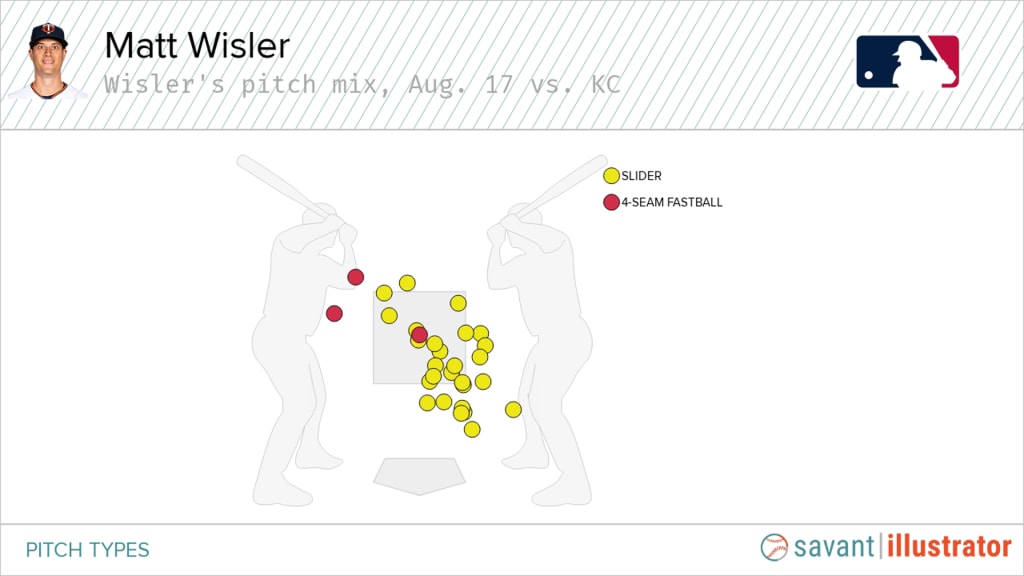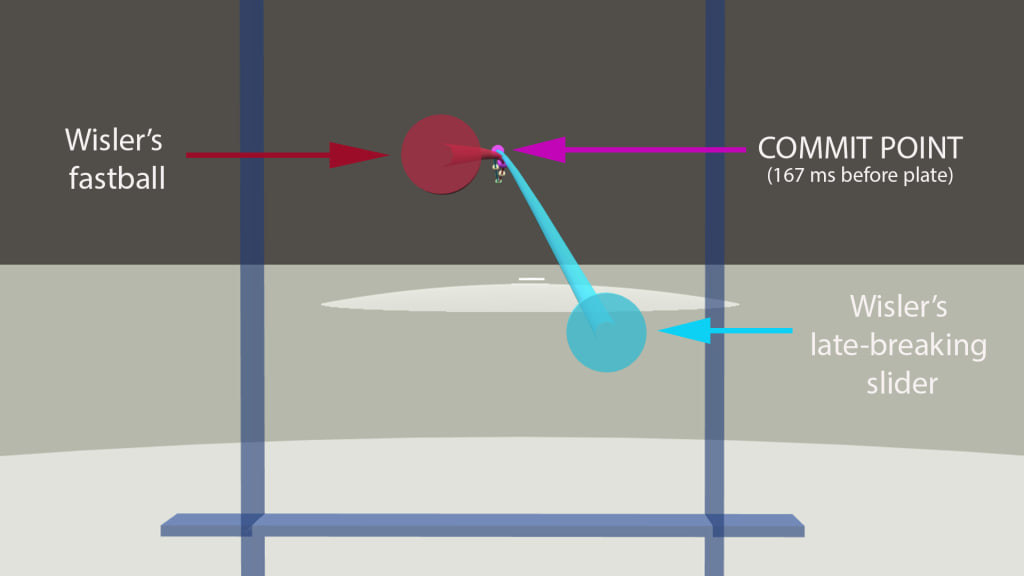There was nothing extraordinary about Twins manager Rocco Baldelli’s decision to start right-handed reliever Matt Wisler as the opener for Minnesota’s series finale against the Royals on Monday. But the way Wisler went about his two innings of work was something modern baseball has rarely seen.
His first pitch to Whit Merrifield was a tight-looping slider at the top of the zone. So was his next pitch, and the pitch after that, and his next four pitches in a row. After hitting Salvador Perez with a fastball, Wisler came back and threw … 11 straight sliders.
By the end of his two scoreless frames, Wisler had twirled a slider on 27 of his 30 total pitches. Out of thousands of games in the pitch-tracking era in which a pitcher tossed at least 25 pitches, Wisler became just the eighth to make at least 90% of them a slider. He’s the only one who’s had the audacity to start a game that way.

“[The slider] feels really good right now,” said Wisler of his favorite toy. “It’s my go-to pitch anyway. I have had really good command and feel for it, so I figure why not just keep throwing it?”
“Go-to pitch” might be the understatement of the year. After Monday’s outing, Wisler has thrown his slider on 151 -- or 78.6% -- of his 192 total pitches in 2020. Fastballs might not be in vogue these days, but what Wisler is doing is more than extreme; it’s borderline historic.
Highest single-year slider usage rates in the pitch tracking era (since 2008)
Min. 150 total pitches
- 86.5% -- Mark DiFelice (Brewers), 2009
- 83.8% -- Mark DiFelice (Brewers), 2008
- 82.2% -- Pat Neshek (Athletics), 2012
4) 78.6% -- Matt Wisler (Twins), 2020
5) 77.8% -- Brian Wilson (Dodgers), 2013
The most a pitcher has used a curveball in any pitch-tracking season is 59.2% by reliever Ryne Harper last year (also for the Twins), meaning it’s been nearly a decade since any pitcher relied on one breaking ball as much as Wisler.
This shouldn’t be working; the coaching staff for every Twins opponent is telling their hitters that Wisler throws almost nothing but sliders. Big leaguers are trained to see the red dot from the seams of the ball that lets them know a slider is coming. Wisler’s low-80s slider is far from the game’s fastest, and it doesn’t top any leaderboard in the way it drops, sweeps or spins.
And yet Wisler, a waiver-wire pickup last winter, owns a 1.50 ERA after his first seven appearances, and ranks among the top 15% of pitchers in Statcast’s whiff rate, hard-hit rate and expected batting average metrics. His opponents have either popped up or struck out 18 times against the slider they know is coming, and reached base just eight times via hit or walk.
It still begs the question of how Wisler is doing this, and maybe part of it is the unpredictability lying within what outwardly appears so predictable. Hitters aren’t picking up the trajectory of Wisler’s slider -- and sometimes he's not always sure where it's going, either.
“You just don’t know what it is going to do,” said Wisler. “I don’t know what it is going to do, so they don’t know what it’s going to do.”
Wisler’s sliders have hit the radar gun at anywhere between 79 to 85 mph this year, so maybe there’s some element of surprise there, too. Twins pitching coach Wes Johnson hinted it could also be something we can’t quantify yet -- at least, on the public-facing side.

“As we know, the later the movement, the better the pitch,” Johnson said. “I should say, the better the chance you have for more swings and misses. And that’s what Matt has with his slider. When [the Twins’ analytics department] saw that during the offseason and signed Matt, I was ecstatic once I got to look at his information, because I thought if we can get this guy in the right roles and do some different things with him he had a chance to really help us out.”
But Wisler is just the tip of the iceberg here ...
Wisler was slider-dominant last year, too, but the way he’s leaned even harder in that direction since coming to Minnesota hints at a whole philosophy developing under Johnson’s tutelage.
Simply put: Spin is in.
Back in July, when Johnson was asked to give a brief overview of how his pitchers had improved since 2019, he mentioned slider work among no fewer than five different pitchers -- Taylor Rogers, Trevor May, Devin Smeltzer, Randy Dobnak and Lewis Thorpe. A cursory glance around the Twins’ pitching staff, and the bullpen in particular, shows all the marks of a veritable slider invasion.
The numbers say the 2020 Twins, who entered Friday with MLB's third-lowest team ERA, are throwing as many sliders as any club in baseball. That’s part of a pronounced veer away from fastballs as a whole, as Minnesota hurlers have thrown secondary pitches on roughly 57% of their offerings this season, on pace to be the highest rate of non-fastball usage by any team -- by a wide margin -- since pitch tracking began.
“I think we're seeing people finding the way to use off-speed pitches better,” Baldelli said. “We're just trying to get outs. That's all we're trying to do. We're trying to find the most effective way to get those outs. But it really does come down to who your pitchers are, what they can do, what their skillsets are, and if they have the ability to throw an effective slider, and then using those sliders to the best of your ability.”
Some of that is the presence of natural slider kings like Wisler and Sergio Romo. But the Twins went fishing a bit, too.
“We went out to get [Kenta Maeda’s] slider,” said catcher Mitch Garver. “We acquired him because of his slider. There you have it, right there.”
Duffey relied on a big, slow curveball for much of his career. No more. Time for a harder pitch with a slider-like break. Statcast indicates that Rogers is throwing his curveball more frequently this season, but nah. That’s a slider, too, Rogers says. Who’s got a nearly 20% spike in his slider usage this season? May, that’s who. How about this new Jorge Alcala kid? Oh, looks like his slider clocks in at 88.5 mph, and he’s throwing it more than 40% of the time.
“I think it is just the realization that if I did that consistently, it would perform very well. That's what they presented to me last spring,” said Duffey, whose slider is, indeed, generating a 50% whiff rate this season. “I think I was at the point where I needed to make an adjustment for my career. They sat me down, all of us down, and all made adjustments, and they seemed to work across the board for all of us."
It’s not just how much the Twins are throwing their sliders; it’s the rather unorthodox way in which they’re bucking convention with those breaking balls.
Remember the prevailing wisdom about making sure not to leave sliders up in the zone? The Twins are actually leading MLB in the percentage of their pitches that are sliders in the upper third of the zone or higher, and roughly 14% of Minnesota’s sliders have climbed the ladder in 2020, nearly double the club’s rate from 2019.
There’s something to that.
"One hundred percent,” Johnson said. “We talk about it with our guys, some of our guys. I don't want to give away some of the guys, but I'll just say you can go look at high cutters in the strike zone, high sliders in the strike zone, and the swing-and-miss rate on those is extremely high. So, yes, to answer your question, there's a gold mine up there with breaking balls."
That mine hides the treasure of a roughly 31% whiff rate on high sliders across MLB this season, a 4% spike from 2019 alone and a 6% increase from where the sport was just three years ago. In other words, teams are finding more swings-and-misses up there.
Not all of the Twins’ pitchers are trying to do that; it’s likely more of a factor for pitchers who throw four-seamers up, and Rogers, a sinkerballer, notes that he’s still attacking the bottom of the zone, and any that stray upstairs for him are misses. The success of the high slider is a trend that’s not lost on many of the Twins’ hurlers all the same.
“I think so many guys have gone to the high fastball now that they are having to mix up looks at the top of the zone because hitters will adjust,” Duffey said. “It's the old cat-and-mouse game. It's never going to stop. … I don't know if I would recommend throwing a hanging slider, but it looks like hanging sliders are in, at least for now."
“Sometimes we’ve been joking, because we’ve noticed that trend as well,” Rogers said. “We’re saying that’s the best pitch in baseball, the high slider.”
High, low, wherever they go, the first-place Twins certainly seem to have developed a historic fixation on the breaking ball, with Wisler’s previously underappreciated slide piece leading the way -- again, and again and again.

